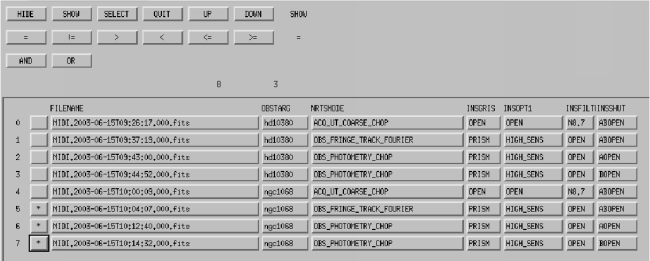"MIA" - Tutorial
We will use for this tutorial the SDT (Science Demonstration Time) data obtained with MIDI for the Active Galactic Nucleus (AGN) of NGC 1068 (S) and the calibrator HD 10380 (C) in it's vicnity on 15 June 2004. The data is provided by ESO. To download the files you have to be a registered user of the ESO archive. Please follow the given instructions. After the download is complete you should have at least the following files, i.e. one calibrated visibility point. Three additional calibrated visibility points are offered.
MIDI.2003-06-15T09:26:17.000.fits.Z HD10380 C Acquisition 20 MB MIDI.2003-06-15T09:37:19.000.fits.Z HD10380 C FringeTrack 110 MB MIDI.2003-06-15T09:38:35.451.fits.Z HD10380 C FringeTrack (continuation) 110 MB MIDI.2003-06-15T09:39:51.901.fits.Z HD10380 C FringeTrack (continuation) 106 MB MIDI.2003-06-15T09:43:00.000.fits.Z HD10380 C Photometry (A) 52 MB MIDI.2003-06-15T09:44:52.000.fits.Z HD10380 C Photometry (B) 52 MB
MIDI.2003-06-15T10:00:09.000.fits.Z NGC1068 S Acquisition 30 MB MIDI.2003-06-15T10:04:07.000.fits.Z NGC1068 S FringeTrack 111 MB MIDI.2003-06-15T10:05:23.451.fits.Z NGC1068 S FringeTrack (continuation) 111 MB MIDI.2003-06-15T10:06:39.901.fits.Z NGC1068 S FringeTrack (continuation) 107 MB MIDI.2003-06-15T10:12:40.000.fits.Z NGC1068 S Photometry (A) 52 MB MIDI.2003-06-15T10:14:32.000.fits.Z NGC1068 S Photometry (B) 52 MB
Use uncompress or a similar tool to unpackt the files:
uncompress <path>/MIDI.2003-06-15T*
where <path> is the path where the downloaded files reside.
Find & Select
-
Make_MIDI_Log
In a first step we want to look what files have beeen received. It's not easy to find tools reading binary fits-tables headers and thus MIA provides two methods. On the one hand a simple IDL procedure that is called make_midi_log. Just type on the IDL prompt
make_midi_log,'<path>',LOGBOOK='<target>/filename.log'
where <path> is the directory where the downloaded files are located. The parameter LOGBOOK specifies the output file. In the default version the procedure reads the keywords providing informations about the observed object, the observing mode, the filter, the shutter, the integration time, and the number of exposures.
-
MIDIGUI
Another way to get that informations is "Gorgonzola":
files=midigui(dir='<path>')
Now a window pops up and lists all MIDI-files in the specified directory. You might have noticed that the number of files is reduced from twelve to eight. "Gorgonzola" recognizes the files that are proceeding volumes in a dataset and doesn't display them. If you now select one or more files by marking them in the first column and pressing the "SELECT" button in the upper part of the panel the names of the files are written into the array files that was specified in the calling command of "Gorgonzola".

To check what is stored in the variable files just typeprint,files
or
print,files[i]
-
MIDIGUIS
A similar routine called with the command
files=midiguis(dir='<path>')
is prefered when handling large numbers of MIDI-files. After the user selected his files the routine writes a binary file to the directory <path>. In this file all the displayed informations are stored, i.e. next time you start midiguis within <path> the routine quickly reads this file instead of processing all the fits-headers again. You will cherish this function when your directory contains dozens of files.